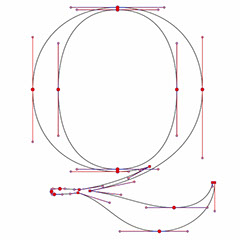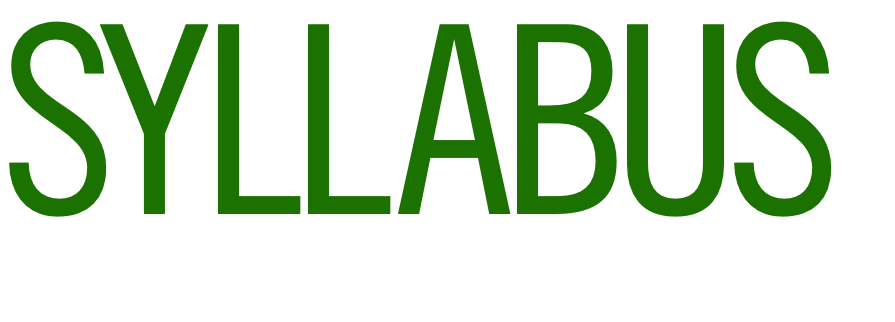

- COURSE DESCRIPTION:
Art 223B Lettering and Typography (3)
Prerequisite: Art 103 and preferably Art223A
History, design and use of letter forms; techniques for rough and comprehensive layouts and introduction to computer graphics. (6 hours activity)
This course will cover the history, theory and practice of letter forms and typography as they apply to graphics, advertising and other areas of design and visual communication.
Projects cover principles of typography, letter structure, typeface selection, fundamentals of computer typesetting, and typographic layout.
________________________________________________________________________
- PREREQUISITES:
Art 103 / 2D Design-Foundation
__________________________________________________________________________
- TEXTS:
Required Books (kind of):
These are our primary sources. It doesn’t mean you HAVE to buy them tonight,
but consider them as a thoughtful investment for your education and career:
> Thinking With Type
By Ellen Lupton; Princeton Architectural Press
> Typographic Design: Form and Communication
Ben Day, Philip B. Meggs, Rob Carter
> The Fundamentals of Typography
by Gavin Ambrose & Paul Harris
- Recommended:
Grid Systems: Principles of Organizing Type
Kimberly Elam
Typographic Systems of Design
Kimberly Elam
Typography Workbook
Timothy Samara, Rockport Publishers
Stop Stealing Sheep and Find Out How Type Works
Erik Spiekermann and E. M. Ginger, Adobe Press
Twentieth-Century Type
by Lewis Blackwell, Yale University Press
The Elements of Typographic Style
by Robert Bringhurst, Hartley and Marks
The Art of Typography
by Christopher Burke and Paul Renner, Princeton Architectural Press
A History of Lettering
Nicolete Gray, Phaidon Press
- Suggested
Texts on Type: Critical Writings on Typography
Steven Heller and Philip B. Meggs, Allworth Press
Grids: The Structure of Graphic Design
André Jute, RotoVision
A Type Primer
John Kane, Laurence King
Unjustified Texts: Perspectives on Typography
Robin Kinross, Hyphen Press
Letter Forms
Stanley Morison, Nattali & Maurice
Typographically Speaking: The Art of Matthew Carter
Margaret Re, Princeton Architectural Press
Basic Typography: Design with Letters
Ruedi Rüegg, Van Nostrand Reinhold
Making and Breaking the Grid: A Graphic Design Layout Workshop
Timothy Samara, Rockport Publishers
Publication Design Workbook: A Real-World Guide to Designing Magazines, Newspapers, and Newsletters
Timothy Samara, Rockport Publishers
Type Rules: The Designer’s Guide to Professional Typography
Ilene Strizver, North Light Books
Printing Types: Their History, Forms, and Use, Volumes I and II
Daniel Updike, Dover Publications
Adobe Classroom in a Book (for Photoshop, Illustrator, InDesign)
Adobe Press
_________________________________________________________________________
- Instructional Process
• Lectures and/or media presentations explaining theory and issues specific to the planning and strategy of the project.
• Examples of previous student work along with professional samples
• Explanation of the problem-solving process, methods of execution, project completion and presentation
• Demonstrations of materials, techniques, process.
• Individual critiques with each student during the studio session. Development in-studio is for the benefit of the instructor’s personal attention and for the opportunity for the student to interact with other students during the design process.
• Class critiques during project development allow students to observe other projects in progress to gain confidence in the verbal presentation of ideas, to express critical evaluation of other student’s projects, and to evaluate their own work.
- Project Submission
At the end of the semester, students are required to upload a compilation folder containing each of their projects in a PDF format.
Students are responsible for obtaining all work (hard copies) saved by the instructor by the beginning of the following semester.
- Learning Activities and Assignments
Quizzes, tests, or papers related to assignments and/or discussion topics may be given at any time.
__________________________________________________________________________
- MATERIALS OF INSTRUCTION:
Many of the supplies can also be purchased at Michael’s.
Register online or download Michael’s app to receive 20-50% off with weekly coupons.
Do not buy new supplies if you already have supplies from other classes.
If you are not sure about supplies please ask me!
Notebook for keeping notes and handouts
Binder (1/2" to 1") with at least 28 clear sleeves (not frosty)
Traveldrive, jumpdrive or flash drive with at least USB2.0 connection that can hold a minimum 1GB of data
14 x 17 inch Canson Tracing Pad
14” x 17” Cotton Comp Paper - Bienfang 360 - ( 14" x 11" ?)
Niji “Stylist” black fine tip pen
Black markers with 2 nibs such as medium & bold
(Sanford PM 98 works well)
Xacto Knife & #11 Xacto blades (bulk pack suggested)
3/16 inch thick Foam-core, black or white sizes TBD as needed.
3M Super 77 Spray Adhesive - (pandemic version?)
3/4 inch White Artist’s Tape
C-Thru Ruler 18 inch (not centimeters)
Metal Ruler 18 inch
White eraser
#2 Pencils (Ticonderoga works well)
Pencil Sharpener
- The following are good to have and to bring to class as needed:
18 x 24 Self-healing cutting matte
Metal T-Square 24 inch
Triangles beveled, 45, 30/60 degrees
Color Pencils
Glue Sticks
Proportion Scaling Wheel
Schaedler Rulers are a smart investment for a designer
Portfolio case to carry/archive large size works
When you are going to shop at art supply stores take your student ID as most stores have student discount!
__________________________________________________________________________
- Learning Activities and Assignments:
Quizzes, tests, or papers related to assignments and/or discussion topics may be given at any time.
__________________________________________________________________________
- Lectures/Discussions:
SENTENCES & PARAGRAPHS
How We Read Pages
- Many different elements can guide the eye in any direction on the page based on color, shape, etc.
- How the reader obtains information is the responsibility of the designer
- Typography is the “guiding light” for a reader’s eye
HOW TO GUIDE THE READER THROUGH HIERARCHY
Basic Hierarchy
- Body Copy, Subheads, Run-in Subheads, Heads and Captions
Choose Type for Hierarchy
Typefaces are designed to be used for specific purposes on a page:
- Display / Decorative
- Subhead
- Text
- Caption
1. Body Copy
2. Subheads
2. Run-in Heads
3. Headlines
4. Captions & Legal
GET ALIGNED
Paragraph Alignments
- Flush Left/Ragged Right, Flush Right/Ragged Left, Centered & Justified
IT’S ALL IN THE SPACING
WEIGHTS
PAIRING TYPEFACES
DASHING THROUGH THE CONTENT
Em, En, Hyphen
PRIMES & QUOTES
Quotes Rules, Hanging quotes
ALWAYS USE A GRID
TYPOGRAPHIC DISCIPLINE FOR LAYOUT
__________________________________________________________________
- Projects and Assignments:
These projects are intended to help students establish the ability to both create and develop an understanding of the principles of typography as they relate to visual organization and composition, information hierarchy, aesthetics, and the communication of ideas.
Of course Projects/Exercises and their order may change anytime to t the overall needs of the class.
- Modular Type: designing a modular typeface based on geometric shapes.
- Morticed Character: (Black Ink paper—Size: 14” x 17”): The the detailed replication and deconstruction of a typographic character, using tracing paper and ink pens.
- Name Initials and images: Students create a hybrid design with combination of their name initials and selected silhouettes.
- Illustrated Word: The illustration of a word to capture visual embodiment of its meaning.
- Image Substitution Exercise: Combining meanings. Replacing one character in a word with and image, creating completely new meaning.
- Type Categories: (Black Ink paper—Size: 14” x 17”): The replication of a character (uppercase and lowercase) in four different styles.
- Event Hierarchy: (B&W) Create a small type notification with different hierarchy in mind.
- Obeying the Rules: (3 or 4-Color (not process)—Size: 5.5” x 8.5”): Students will produce a multi-paneled booklet that feature guidelines on successful type usage (26 panels).
- Type Specimen: (2 or 3-Color—Size: TBD): Design a poster to introduce one of the typefaces from the given list.
Presentation of Typographic Readings: Students will deliver a classroom presentation on one of the many reading assignments selected from Thinking With Type or they can deliver a presentation on a topic by their choice. They must discuss their subject with instructor and get his approval. Students will also moderate a class discussion afterward if there are any questions.
__________________________________________________________________________
- Assessment and Evaluation:
The course grading criteria is based on students’ demonstration of the following:
y Development of concepts that are thoughtful, original and creative
y Careful attention to execution, technique and completion of projects
y Effective visual and verbal presentation skills
y Active and verbal participation in class activities and critiques
y Attendance with necessary materials and assignment preparation • Personal challenge and effort in project development
y Deadline compliance
y Maintaining currency with reading assignments
y Participation in class discussions
__________________________________________________________________________
- Grade Breakdown:
Critiques and feedback on main projects will revolve around individual critiques, round table critiques, and wall critiques.
Projects will be graded on personal challenge, self-motivation, and attitude in exploration in the development of self-generated graphic design imagery.
If a project is worth 10 points, its individual stages (thumbnail, rough, comp) are graded on the following point system:
10=Flawless
9= Excellent
8= Good
7= Average
6= Weak
Counting the final comp twice, the final grade on any project is based on the average grade of the individual stages, for example:
Initial Sketches: 8
Rough: 8
Final Comp: 9
Final Comp: 9
8+8+9+9= 34 / 4 = 8.5
A total of 100 points are possible for the course. Final course grades are issued based on a straight percentage: 93 points = A. Points will be allocated as follows:
FINAL GRADE CRITERIA
A 93-100
A- 90-92
Clearly stands out as excellent performance and, exhibits mastery of learning outcomes
B+ 87-89
B 83-86
B- 80-82
Grasps subject matter at a level considered to be good to very good, and exhibits partial mastery of learning outcomes
C+ 77-79
C 73-76
C- 70-72
Demonstrates a satisfactory comprehension of the subject matter, and exhibits sufficient understanding and skills to progress in continued sequential learning
D+ 67-69
D 60-66
Quality and quantity of work is below average, exhibits only partial understanding and understanding and skills are not acceptable to progress in the graphic design
F 59-
Quality and quantity of work is below average and not sufficient to progress
__________________________________________________________________________
- Class Policies and Guidelines:
Attendance and Participation
• Roll will be taken in the first 15 minutes of the beginning of class
• Arriving to the class between 1:00pm - 1:15pm is considered a tardy
• Missing more than 30 minutes of class is considered an absence
• 3 tardies is equal to one absence
• Two missing will lower your grade one point. (ex: B to B-)
• If you miss 3 sessions, you will be dropped automatically. (TBH it is already unusual situation, don't make it harder!)
A medical withdrawal from the course is recommended for illnesses extending beyond 1 class session.
Late Work?
The answer is NO.
____________________________________________________________
- Students with Learning Disabilities:
Students seeking disability support and accommodation resources should contact the Disability Support Services (DSS).
The DSS has been designated as the campus authority to verify disabilities and to prescribe specific accommodations for students with documented disabilities.
Individualized programs are designed that enable students to compete academically on an equal basis with their non-disabled peers.
Academic accommodations and support services are available to students who have mobility, visual, or hearing impairments, chronic health conditions,
and/or attention, learning or psychological disorders.
________________________________________________________
- Code of Student Conduct:
If you don't know it, its here.
Read it once for the rest of your academic life,
It is the same all around the world (almost).
__________________________________________________________________________
- Last but not least:
This class like my other classes is a two-way course. The purpose of this class is not solely for learning technical skills, but to develop our vision to look at things differently.
The art and design world has endless excitement to discuss. So, make yourself comfortable by bringing your point of view to this class while we respect each other and make a professional connection through this course. Considering this awkward moment of life that we are all experiencing, I'm looking forward enjoying this class as break-time for our real life.
We all learn from each other. Let’s do it Titan Type I people.
-Omid
__________________________________________________________________________